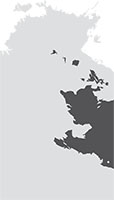- Home
- Energy
- Onshore sedimentary basin inventories
- Georgina Basin
Georgina Basin
Quick facts
Overview
The Georgina Basin is a frontier basin containing all the right elements for fertile petroleum systems and a range of mineral commodities, particularly phosphate, at explorable depths.

The Neoproterozoic to Devonian Georgina Basin is a widespread intracratonic basin initiated as part of the Centralian Superbasin and extends east into Queensland. The northern and central part of the basin comprise a relatively shallow platformal Cambrian succession, while the southern parts of the basin contain a thicker Neoproterozoic to Devonian succession that deepen towards the southern margin with the Aileron Province. The Georgina Basin unconformably overlies Palaeoproterozoic Murphy, Warramunga and Davenport provinces, Palaeo-Mesoproterozoic McArthur and South Nicholson basins and Lawn Hill Platform, and in fault contact with Palaeo-Neoproterozoic Aileron Province. Interpreted to be contiguous with Neoproterozoic to Palaeozoic Wiso and Daly basins that developed as distinct depocentres isolated by basement highs formed from the Cambrian Kalkarindji Province. It is unconformably overlain by Mesozoic Carpentaria and Eromanga basins. The stratigraphy comprises sequences of dolostone, limestone, shale, sandstone and siltstone.
The Georgina Basin has been explored since the 1950s with numerous wells reporting oil and gas shows. The Ethabuka-1 well, just across the border in Queensland, produced a sub-commercial gas flow of ~200 Mcfd from the Coolibah formation in the 1970s. More recent exploration has been targeting conventional and unconventional gas resource potential of the lower Arthur Creek Formation in the southern Georgina Basin. In 2011-12, under a JV between Statoil Australia and PetroFrontier Corporation, three vertical wells and horizontal sidetracks were drilled, with Owen-3H and MacIntyre-2H both successfully stimulated and completed. Good gas shows were recorded in all three wells, with oil seepage reported in Owen-3 and oil fluorescence in Owen-3H. In 2014, Statoil drilled five wells targeting the lower Arthur Creek Formation. Three of these wells showed strong oil shows, but flow testing of two wells was unsuccessful. Exploration since 2014 has been limited, although Global Oil and Gas Ltd (formerly Baraka Energy) have investigated hydrogen and helium potential of the southern margin of the basin.
Petroleum
The southern Georgina Basin contains a thick middle Cambrian succession that contains organic rich shales that belong to three known petroleum systems- the Thorntonia, Arthur Creek and Hagen systems (Munson, 2014). Although no commercial discoveries are known, there are multiple oil shows throughout the Cambrian succession and numerous conventional stratigraphic and structural traps have been identified within the basin highlighting the petroleum prospectivity of the basin. Central Petroleum Ltd and Global Oil and Gas Ltd have been targeting the unconventional gas resource potential of the lower Arthur Creek Formation.
Other energy potential
Exploration for potential helium and hydrogen by Global Oil and Gas Ltd is also occuring in the southern Georgina Basin.
Minerals commodities
For an overview of the mineral prospectivity view the Geology of the Northern Territory Chapter 28 Georgina Basin and the mineral commodities pages.
In late 2021, Global Oil and Gas Ltd commenced exploration for helium and hydrogen on EP127 on the southern margin of the Georgina Basin. The company undertook a near-surface, helium soil gas sampling program across 49 sites and identified an area of elevated helium gas values that the company reported was an indication of an active helium system in the area.
More detailed description of the petroleum potential of the Georgina Basin can be found in NTGS Report 22. The southern Georgina Basin has good seismic and petroleum well coverage.
Open file petroleum company reports and all NTGS data and information on Georgina Basin can be found on the GEMIS website.
Munson, TJ, 2014 NTGS Report 22: Petroleum geology and potential of the onshore Northern Territory




